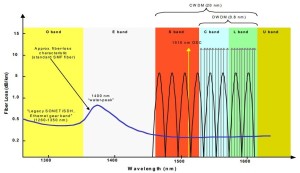Because of the rapid development of data services, the speed of network convergence is accelerating, MAN is becoming a focus of network construction, market competition pressure makes the telecom operators more sensitive to the cost of network. Aimed at the demand of the market, low-cost MAN CWDM products arises at the moment.
With full spectrum CWDM league (FCA) vigorously promote of CWDM Technology and ITU-T for the standardization of CWDM, it makes CWDM technology equipment manufacturers and operators be the focus of attention. The ITU-T 15th team through CWDM wavelength grid of standard G.694.2, and become a milestone in the history of the development of CWDM technology. The 15th team also puts forward the definition of CWDM system interface right app draft standard. Shanghai bell and other companies in China in the standardization of CWDM technology also has made certain contribution, relevant domestic standards are also under discussion.
As the the growth of the market demand and the standardization of CWDM technology rapidly, many communication equipment manufacturers such as Nortel, Ciena, Huawei, alcatel Shanghai bell (asb), fire network developed related products and gain a wide range of applications in the market.
CWDM system is a low cost WDM transmission technology towards MAN access layer. In principle, CWDM is using optical multiplexer to different wavelengths of light to reuse the signals to single fiber optic transmission, at the link of the receiving end, with the aid of photolysis of multiplex fiber mixed signal is decomposed into different wavelength signal, connected to the corresponding receiving equipment. And the main difference with DWDM is that: compared with the 0.2nm to 1.2 nm wavelength spacing in DWDM system, CWDM Wavelength Spacing is wider, wavelength spacing of 20 nm industry accepted standards. Each wavelength of band cover the single-mode fiber system of O, E, S, C, L band and so on.
Because of CWDM system has wide wavelength spacing and low demand to technical parameters of laser. Since wavelength spacing up to 20 nm, the system maximum wavelength shift can reach -6.5℃~+6.5 ℃, the emission wavelength of laser precision can be up to +/- 3nm, and the working temperature range (-5℃~70℃), wavelength drift caused by temperature change is still in the allowable range, laser without temperature control mechanism, so the structure of the laser greatly simplified, yield improvement.
In addition, the larger wavelength spacing means recovery device/solution of multiplexer structure is greatly simplified. CWDM system, for example, the CWDM Filter layer coating layer can be reduced to 50, and DWDM system of 100 GHZ filter film coating layer number is about 150, resulting in increased yield, cost reduction, and the filter supplier has greatly increased competition. CWDM filter cost less than the cost of DWDM filter about more than 50%, and with the increase of automation production technology, it will be further reduction.
Still CWDM positioning the short distance transmission in metropolitan area network (within 80 km), and channel rate is generally not more than 2.5 Gbps, so there is no need for light amplification, dispersion, nonlinear and other considerations in the transmission lines, then you can make the system is simplified.
By means of some of these, by expanding wavelength spacing and simplifying equipment, the cost of optical channel made the CWDM system unit can be reduced to 1/2 or even 1/5 of the DWDM system, it has strong advantages in the metropolitan area network access layer.
Fiberstore is a quite professional store of providing optical fiber products, if you want to know more related products information, welcome to contact us.








